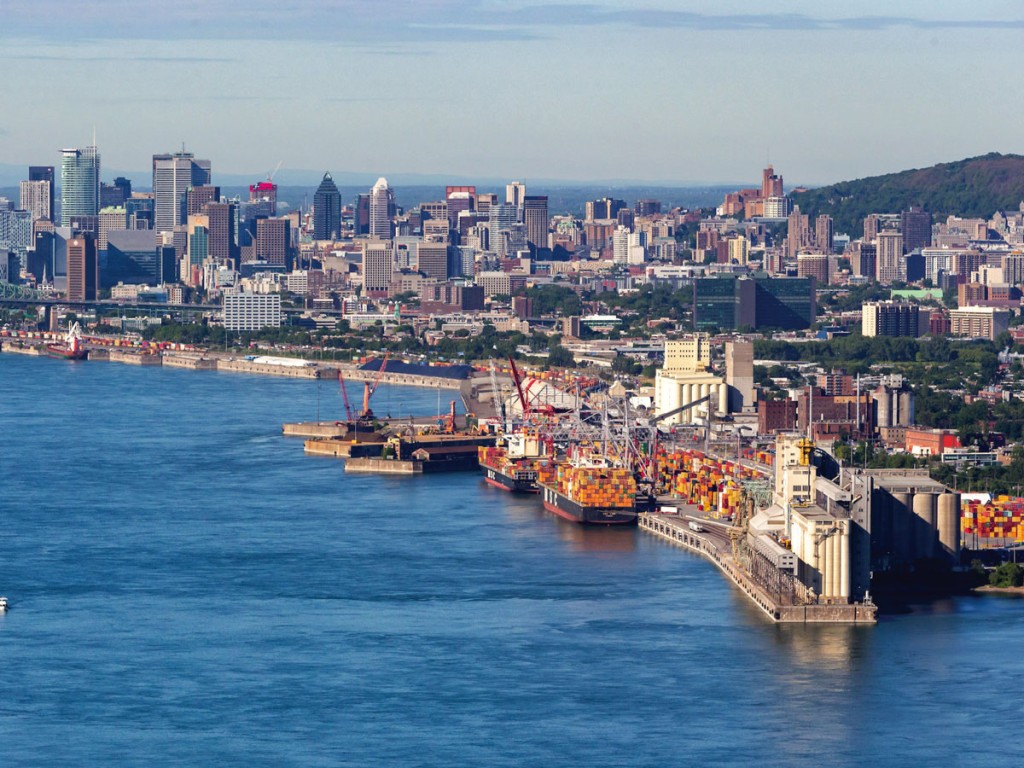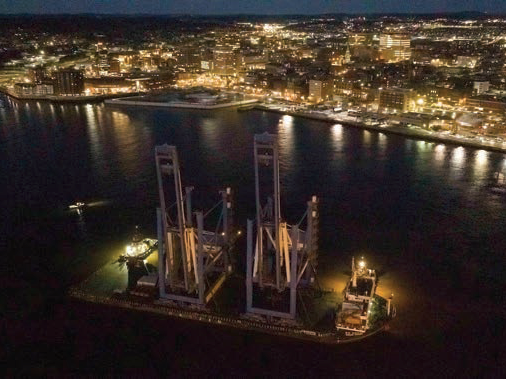Like their peers in the U.S. Northeast, Canada’s ports on the eastern seaboard, especially those focusing on container shipping and operations, today’s global environment of lackluster economic growth and geopolitical turmoil is not weakening their resolve to take the necessary steps to remain competitive and position themselves for future cargo demands. Supply chain, capacity and decarbonization are key challenges being addressed.

Port of Montreal
For the Port of Montreal, second largest in Canada after Vancouver, current cargo trends showing a moderate decline in the low single digits (through February) suggest it will not likely match in 2023 the 2022 results of 35.4 million metric tons and a 2% volume gain in container traffic. In 2021, the port handled 34 million tons and 1.7 million TEUs. The Midwest accounts for 10% of the container business of the port, and seven out of ten containers destined for the Midwest come from Northern Europe.
Last year, in fact, marked a major turning point in Montreal’s international maritime trade relations. The Port of Montreal’s main partner country in the container sector became India. The latter overtook Germany, which in recent years had taken top spot away from the United Kingdom in a post-Brexit development. In all, close to 1.6 million tonnes of containerized cargo to and from India were handled at Montreal in 2022.
Over the past 10 years, the Port of Montreal has greatly diversified its markets. Today, cargo handled at the port comes not only from Northern Europe, but also from the Mediterranean, Asia, the Middle East, Africa, and Latin America. Germany remains the main partner in Northern Europe and the second largest overall for the year 2022.
Over the last five years, the Port of Montreal’s volumes have basically doubled with India, a major export market. The main commodities exported are lentils, forest products and steel. India mainly imports construction materials and rice.
The growth in volumes with India is largely due to the four weekly direct services by marine carriers between Mediterranean transshipment ports and the Port of Montreal.
“India and Southeast Asia generally represent high potential growth. This clearly shows the role the Port of Montreal plays to support Canadian companies in trading with the Indo-Pacific region,” comments Guillaume Brossard, VP development, marketing, and international relations.
Martin Imbleau, president, and CEO recently indicated that the port has earmarked C$335 million in a new five-year investment plan as it is approaching full container capacity. This blueprint aims to accelerate the decarbonization of operations and modernize infrastructure on the Island of Montreal to notably improve the fluidity of rail traffic and vessel-handling.
Meanwhile, the Quebec government in late March added an additional financial support of C$75 million for the Port of Montreal’s Contrecoeur container terminal project aiming to increase container-handling capacity by 1.15 million TEUs. This came on top of a previous commitment of $55 million plus the $300 million from the Canada Infrastructure Bank. Federal government funding has also been requested for a project whose cost is expected by analysts to well surpass the original estimate of C$750 million, given the dramatic rise in interest rates and inflation. The announcement of the winning bidder for construction, financing and operation is slated for the third quarter of this year.
Port of Halifax
Recent developments confirm that Nova Scotia’s Port of Halifax has entered a new growth chapter in its history, as illustrated by record 2022 container numbers and forthcoming significant increases in cargo-handling capacity. Its deepened harbours have attracted some of the largest containerships calling on the East Coast of North America.
Last year saw the port cross the 600,000 TEU annual throughput threshold for the first time. Precisely 601,700 twenty-foot equivalent units (TEU) moved through Halifax’s container terminals: PSA Halifax Atlantic Hub and PSA Halifax Fairview Cove. Central Canada and the U.S. Midwest are the biggest markets.
“In 2022, PSA Halifax, CN and the Halifax Port Authority worked together in a collaborative, meaningful way, and the increased throughput volume is a positive outcome of that collaboration,” commented Captain Allan Gray, President and CEO, Halifax Port Authority (HPA). “In 2022, we started using the Joint Operation Centre for containerized cargo operations and that certainly helped find new efficiencies and maintain cargo fluidity with no vessel berthing delays during a second year of sustained supply chain disruptions.”
In April of last year, the HPA joined the World Port Climate Initiative (WPCI) as an Incentive Provider with the International Association of Ports and Harbours’ Environmental Ship Index (ESI). The HPA is now offering incentives to container and Ro/Ro vessels that voluntarily register and meet ESI’s requirements in reducing greenhouse gas emissions. The program has been successful in reducing emissions by 13% on 40% of vessel arrivals, the port reports.
This past March, PSA Halifax announced that it has signed an agreement with the Finnish Industrial Equipment company Konecranes to purchase eight new electric Rubber Tired Gantry cranes (E-RTGs) for its Atlantic Hub terminal. This purchase will expand the terminal’s handling capacity by 25 percent and is part of PSA’s efforts to electrify its equipment fleet, which will help it meet its sustainability and decarbonization objectives. The new E-RTGs will arrive by the 2nd quarter of 2024 and increase the Atlantic Hub Terminal’s total RTG fleet from nine to 17.

Port Saint John
Amongst the top five of Canadian ports in total tonnage, Port Saint John has in recent years seen its container throughput benefit from total investments of about C$500 million in infrastructure and supply chain upgrades along with the growing presence of such global carriers as Hapag-Lloyd and Mediterranean Shipping Company vessels and the launching of an international intermodal service by Canadian Pacific Railway. The Bay of Fundy port, which handled nearly 29 million tons and 87,000 TEUs in 2021 (according to available complete figures) is in the midst of a concerted campaign to enhance its position as an important Atlantic maritime gateway to Central Canada and the U.S. Northeast and Midwest.
In the above context, DP World and Port Saint John welcomed two additional post-Panamax cranes last January to the container terminal.
The arrival of the cranes marked a significant milestone in Port Saint John’s C$205 million modernization project. This project, a three-way partnership venture between the Government of Canada, the Province of New Brunswick, and Port Saint John, is slated to be completed this year. The modernization program deepening quayside draft and increasing the on-dock rail sector will bolster container capacity to 300,000 TEUs.
“We are thrilled to be a part of the long-term, sustainable economic growth of Saint John and the Atlantic region,” said Maksim Mihic, CEO and General Manager DP World (Canada) Inc. “With connections to 500 ports worldwide, intermodal transportation and three class one railways, Port Saint John is well positioned for growth for the foreseeable future. The investments being made throughout the trade-eco-system including logistic services will make the port a more competitive gateway for decades to come.”
The additional cranes bring the total to four at the port. The Hyundai Heavy Industries Container Cranes have an outreach of 190 feet and can reach up to 21 containers wide and are capable of servicing vessels with a capacity of between 10,000 and 14,000 TEUs.
“The arrival of these two cranes is symbolic of the growth we can offer not only to port business, but also to our community and our region,” says Craig Bell Estabrooks, President and CEO of Port Saint John. “Soon we will have more than double the capacity to move product and to create jobs. Partners like DP World open doors for us and our local economy to pursue new opportunities for our industrial parks, our supply chain, and manufacturing capacity.”
In a related recent development, Canada’s federal government allocated C$10 million in funding for two projects under the National Trade Corridors Fund. Up to $7.3 million will be for the remaining phases of rehabilitating the Saint John Harbour Bridge. The remainder goes to providing additional space for the Canada Border Services Agency to carry out inspection activities for cargo arriving at Port Saint John.





